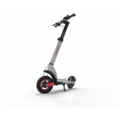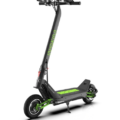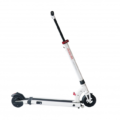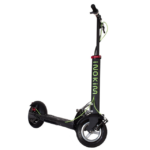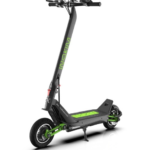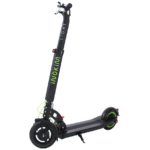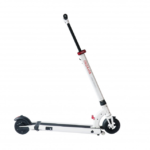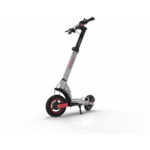- Home
- Scooters
- Electric Scooters
- INOKIM OX
INOKIM OX
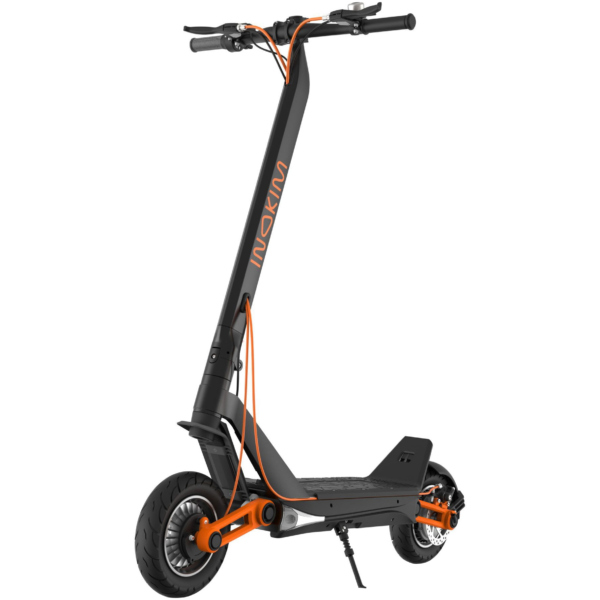


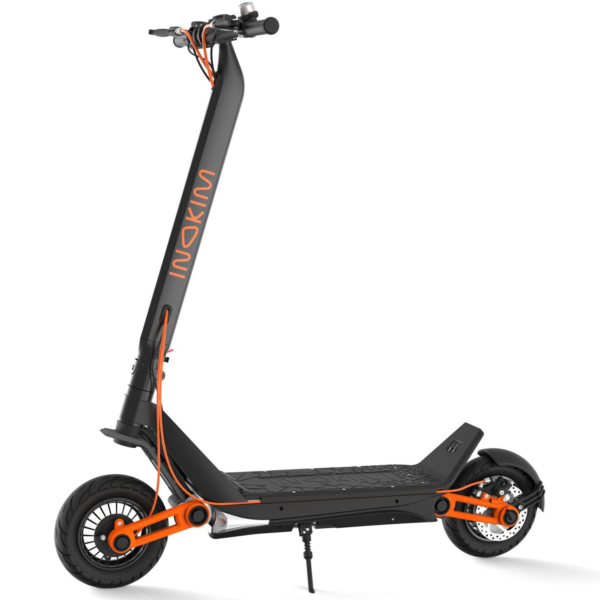
- Battery Range: 22–37 miles (35–60 km)
- Top Speed: 28 mph (45 km/h)
- Motor Power: 1000 W
- Weight Capacity: 265 lb (120 kg)
- Charging Time: ~7–12 h
- Scooter Weight: 61.7 lb (28.0 kg)
PROS
- Adjustable front & rear suspension
- Robust 1000 W rear motor
- 10″ pneumatic tires
- Dual disc brakes
- Solid build for mixed terrain
CONS
- Heavy for daily carry
- No Bluetooth app
- IP rating not specified
- Premium price tier

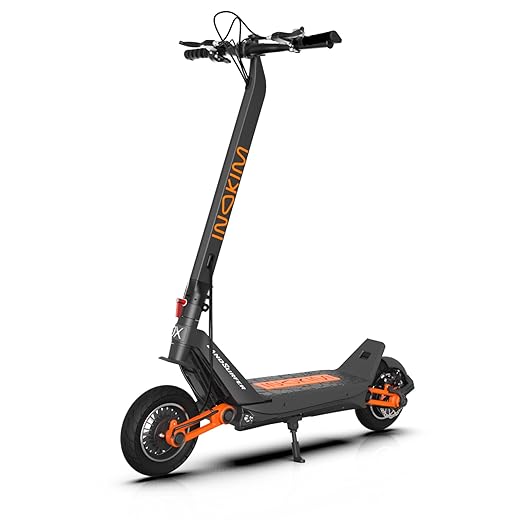
Key Takeaways
- The INOKIM OX is a versatile scooter designed for smooth handling and durability.
- It comes in Hero and Super trims, featuring different battery capacities for various ranges.
- With a 1000 W motor, it provides controlled acceleration and steady speeds.
- The scooter prioritizes comfort with rubber suspension that absorbs bumps effectively.
- It is suitable for commuters and weekend riders, but not ideal for those needing to carry it frequently or navigate steep hills.
Table of contents
- What Is the INOKIM OX?
- How the INOKIM OX Works
- Key Specifications
- Design & Build Quality
- Performance Fundamentals
- Battery, Range & Efficiency
- Ride Quality & Comfort
- Braking & Safety Features
- Portability & Daily Usability
- Maintenance & Care
- Weather & Seasonal Considerations
- INOKIM OX vs Alternatives
- Who the INOKIM OX Is (and Isn’t) For
- FAQs
- Glossary
The INOKIM OX is a tough, quiet single-motor scooter made for real daily riding. It feels stable on city streets and calm on light trails, and it keeps that feel as miles add up. If you want a clean design, simple controls, and a chassis that just works, the INOKIM OX makes a strong case. If you want a lighter city build from the same family, check the INOKIM Light 2.
What Is the INOKIM OX?
The INOKIM OX sits between fast commuters and full-on trail beasts. It focuses on smooth handling and long-term durability. Most markets offer two trims. The OX Hero carries a 57.6 V 13 Ah battery that keeps weight down. The OX Super steps up to a 57.6 V 20.8 Ah pack for longer rides.
You notice the build right away. Thick aluminum castings. Single-sided suspension arms. A wide deck with room to move your feet. And a cockpit that stays tidy and easy to read. It looks simple on purpose, and it rides that way too.
How the INOKIM OX Works
Motor. A rear 1000 W brushless hub sits in the wheel. Power comes on smoothly, then builds as you roll the throttle. So starts feel controlled, and lane changes stay clean.
Controller. Think of it like a careful faucet. You press the thumb lever, and the controller meters current in a steady stream. Then it feeds a bit more as speed rises, which keeps traction predictable.
Battery. Two options cover most riders. The Hero’s 57.6 V 13 Ah pack suits shorter daily loops. The Super’s 57.6 V 20.8 Ah pack fits longer routes. A BMS looks after the pack during charge and discharge.
Throttle. A thumb lever lives beside a simple LCD. The angle feels natural, so your hand stays relaxed on longer rides. Low-speed control in tight spaces is easy too.
Brakes. Up front you get a drum for smooth initial bite. In back you get a disc for strong stops. Some batches ship with a hydraulic rear caliper. Lever feel stays progressive, so you can scrub speed without a jerk.
Key Specifications
Below is a clean snapshot of the official core data and common trim details. Values appear in both units for quick checks. This section uses the word specifications by design, and you will see it a few more times in this guide.
| Block | Item | Value |
|---|---|---|
| General | Model | INOKIM OX (Hero and Super trims) |
| Top Speed | 27.9 mph (45 km/h) | |
| Rated Range (Super) | Up to 60 mi (96 km) | |
| Max Load | 265 lb (120 kg) | |
| Weight | ~62 lb (28 kg) | |
| Performance & Power | Motor | 1000 W rear brushless, gearless hub |
| Drive | Rear-wheel drive | |
| Tires | 10 × 2.5 in pneumatic (≈ 25 × 6.4 cm) | |
| Battery, Charging & Electrical | Battery Options | Hero: 57.6 V 13 Ah; Super: 57.6 V 20.8 Ah |
| Energy (approx.) | Hero ≈ 750 Wh; Super ≈ 1200 Wh | |
| Charge Time | About 7–10 hours with the included charger | |
| Display | INOKIM LCD with thumb throttle | |
| Build & Dimensions | Frame | Aluminum alloy |
| Suspension | Adjustable rubber torsion arms, single-sided | |
| Folded Dimensions | 48.0 × 23.2 × 21.3 in (122 × 59 × 54 cm) | |
| Safety & Control | Brakes | Front drum, rear disc; some units rear hydraulic |
| Lights | Integrated front and rear LEDs | |
| Water Resistance | IPX4 (splash-resistant) | |
| Features & Extras | Cruise Control | Yes when enabled in settings |
| Ride Modes | Multiple speed modes | |
| Warranty & Compliance | Warranty | Typically 12 months (region dependent) |
| Compliance | Regional electrical safety compliance noted by sellers |
Check your local listing for trim, battery label, and small hardware differences. Parts vary a little from batch to batch, and it helps to match numbers before you order spares.
Design & Build Quality
The OX looks minimal, and that’s the point. Cast parts line up cleanly, and bolts sit flush. Cables tuck in along the stem and the deck, so there is little to snag. You can tell a lot of thought went into how the scooter gets used day after day.
The deck is long and wide. You can set your front foot across and your back foot at an angle, then shift weight under braking without cramped toes. Grip varies by batch. Some decks ship with a rubberized layer. If you ride wet streets often, add coarse grip tape for extra bite.
The stem feels stout under load. Hard stops and mid-corner bumps do not shake it much. The folding latch closes with a positive click, then sits out of the way while you ride. Once folded, the package fits most hatchbacks with the seats down, and it stands neatly by a desk.
Swingarms pivot on robust hardware with rubber suspension blocks doing the heavy lifting. No springs to preload. No oil dampers to service. And very little noise as the miles stack up.
Performance Fundamentals
The INOKIM OX favors calm, predictable speed. From a stop the pull builds in a smooth arc. That feel helps in bike lanes and around traffic. It also helps new riders learn the throttle without surprises.
At speed the scooter tracks straight. The wheelbase runs long for this class, and most of the mass sits low in the deck. So the steering feels settled, not twitchy. If wind picks up, slide your stance forward and loosen your elbows a touch. Then the chassis shrugs off gusts better.
Climbs in the 7–10% range feel honest for a single-motor setup. Start with a little rolling speed, keep steady pressure on the lever, and let the controller feed current as the grade ramps. Speed will taper, yet traction stays composed on dusty or damp pavement. On very long hills in hot weather, take a short breather at the top. Then ride on once heat drops.
Battery, Range & Efficiency
Range makes or breaks daily rides, so let’s set simple expectations. The OX Super’s 57.6 V 20.8 Ah pack targets longer routes. The OX Hero’s 57.6 V 13 Ah pack suits shorter commutes and lighter bikes. The Super carries a rated figure up to 60 miles (96 km) in easy conditions. Real-world numbers swing with rider weight, hills, wind, surface roughness, and temperature.
So how do you plan? Start conservative. Aim for half the rated number during your first weeks, then move the target as you learn your route and pace. A 175 lb (79 kg) rider on mixed streets at 68–77 °F (20–25 °C) lands far below the lab result, yet still covers a healthy daily loop.
Cold trims range. Cells give less energy near freezing. So pick shorter rides or lower cruising speeds in winter. Heat matters too. On very hot days, long climbs raise pack and controller temps. Then the system may pull power a bit to protect parts. A brief rest in shade brings performance back.
Charging habits help packs age well. Let the scooter sit a few minutes after a hard ride before plugging in. Keep dust caps closed. Store around 50–70% if it will sit for weeks, then bump it back to storage level monthly. And top off the night before long rides, not days ahead.
Ride Quality & Comfort
Comfort is where the INOKIM OX often wins. The rubber torsion arms soak up cracks and joints that rattle many scooters. Small potholes turn into soft thuds, not sharp hits. And the system keeps quiet while it works.
Ride height can be flipped by changing linkage position. Pick more ground clearance for light trail days. Pick the lower stance for smooth streets and a sportier feel. The change is quick once you have done it once, and it gives you control over how the scooter sits.
Tires are 10 × 2.5 in and pneumatic. The contact patch is generous for this size, and the sidewalls add compliance. Keep pressures in the mid-40 psi range for average riders, then adjust a few psi to taste. Lower pressure boosts grip and comfort at the cost of range. Higher pressure rolls faster and fights pinch flats. Weekly checks pay off.
Stem behavior stays tidy. Wobble is rare when the headset is set correctly and wheels are true. If you feel a wiggle, check headset tension and front tire balance first. Then confirm rear axle tightness and rotor alignment. Small fixes go a long way.
Braking & Safety Features
Balanced braking builds confidence fast. The front drum offers smooth, linear bite that resists instant lock-up on dust or wet paint. The rear disc supplies the muscle for quick stops. Lever travel ramps in a predictable way, so you can trim speed through a corner without a snap.
Lights are integrated into the deck area, which helps you get seen. A bar-mounted headlight at chest height still makes night rides better, since it throws farther and shows road defects sooner. Reflectors on the fork and rear frame add side visibility at intersections. The platform lists IPX4 for splash protection, so drizzle and light puddle spray are within the design. Standing water is not.
Wet riding changes traction fast. Painted lines and metal plates get slick. So slow down, ride straight across markings, and leave extra room to stop. Then dry the scooter and wipe pivot points and the rotor when you get home.
Portability & Daily Usability
For a scooter this solid, portability holds up well. The OX weighs about 62 lb (28 kg). You can lift it into a trunk or up a short set of stairs, though planning helps when elevators are out. A simple strap or pad stops the deck from scuffing car trim.
The fold is straightforward. Release the latch, lower the stem, and secure it. Folded size sits around 48.0 × 23.2 × 21.3 in (122 × 59 × 54 cm), so it fits many hatchbacks with the seats down. In offices, it stands along a wall without stealing a whole hallway.
Daily touch points feel sorted. The kickstand leans the scooter at a safe angle. The charging port is easy to reach. And the LCD stays readable in daylight. For security, use a real frame-rated lock for long stops, plus a short cable for the front wheel if you must leave it outside.
Maintenance & Care
A small routine keeps the INOKIM OX tight and quiet.
Before every ride.
Check tire pressure. Squeeze both levers to confirm firm feel. Spin wheels to spot rubbing or a bent rotor. Scan stem and swingarm hardware for play.
Weekly.
Wipe dust from fork and swingarms. Inspect pad wear and cable tension. Tug the headset forward and back to check for movement. Then snug hardware to spec if needed.
Monthly.
Torque-check major fasteners with a calibrated tool. True wheels if a hop creeps in. Clean the deck and renew grip if shoes slip. Align the rear caliper so the rotor runs clear.
Battery care.
Store around half charge if the scooter will sit. Keep the deck dry. Charge in a cool place away from direct sun. Then give the pack a few minutes to settle after a full charge before a demanding ride.
Smart habits stretch consumable life. Pads last longer when you avoid dragging them on long downhills. Tires live longer at correct pressure. Bearings stay smooth when you avoid deep puddles and keep water away from pivots during washes.
Weather & Seasonal Considerations
Weather shifts how the OX feels. Light rain rides fit within the IPX4 envelope, so quick trips in drizzle are fine with care. Slow a bit. Brake earlier. Keep the scooter upright over slick paint and metal. Then dry metal parts after the ride.
Heat stresses packs and controllers on long climbs. Park in shade when you can. Give the scooter a short rest after steep hills. Cold trims range and stiffens rubber. Plan shorter loops, set tire pressure a touch higher to offset contraction, and dress warm so your inputs stay smooth.
Roads change with seasons too. Spring leaves sand at corners. Autumn drops leaves that hide slick spots. Winter creates small cracks that can catch a narrow tire. So scan ahead, trim your peak speed, and stay centered over the deck when grip fades.
Local rules vary by city and region. Speed limits, lane access, and lighting rules change more than you think. Ride defensively and match posted signs.
INOKIM OX vs Alternatives
Riders usually compare three groups: fast commuters, trail-ready dual motors, and ultralight last-mile models.
Against fast commuters.
The OX brings steadier steering and a calmer ride than many rivals. It runs quiet over broken pavement and offers a roomy deck. Some competitors show higher peak speed, but they often feel twitchy or harsh.
Against trail-ready dual motors.
Dual motors leap off the line and climb steeper grades. They weigh more and need more setup attention. The OX trades raw punch for low noise, simpler service, and easier daily living.
Against ultralight last-mile scooters.
Featherweights win on carry weight and tiny folds. For a compact budget ride, take a look at the Hover-1 Neo V. They give up comfort, stability, and braking force. So if you carry the scooter a lot, go small. If you ride farther and want a planted chassis, pick the OX.
That’s the balance. The INOKIM OX favors poise over fireworks, and it pays you back with calmer rides and fewer surprises.
Who the INOKIM OX Is (and Isn’t) For
Great for:
Commuters who ride several miles each way. Students who split time between streets and campus paths. Riders who want simple controls and a frame that stays aligned. Weekend explorers who like packed dirt or gravel without technical trails.
Not ideal for:
Travelers who must carry a scooter up many stairs. Speed hunters who want instant arm-stretch thrust. Residents of very hilly towns with daily steep climbs. Riders who fold and unfold the scooter many times per trip.
Think about your route, storage space, and how often you will carry the scooter. Then match the tool to the job you actually have.
FAQs
How fast does the INOKIM OX go?
The rated top speed is about 27.9 mph (45 km/h). Real speed shifts with rider weight, grade, wind, and tire pressure.
What range should I expect day to day?
The OX Super can reach up to 60 miles (96 km) in easy settings. Most riders see less on mixed routes, especially in cold or hilly cities.
Is it water-resistant?
The platform lists IPX4 for splash protection. Light rain is fine with care. Standing water raises risk to bearings and electronics.
What tire size does it use?
It runs 10 × 2.5 in pneumatic tires. Keep inner tubes on hand and check pressure weekly.
Does it have cruise control?
Yes on many units when you switch it on in the menu. It holds a set speed on flat ground after a short period of steady throttle.
Which trim should I choose, Hero or Super?
Pick the Hero for lower weight and shorter charge time. Pick the Super for longer rides and fewer charges. Match the pack to your commute length.
Where can I read an INOKIM OX overview in one place?
Right here. This page brings key points, care tips, and core specifications together.
Glossary
Ah (ampere-hours). Battery capacity that reflects stored charge.
Wh (watt-hours). Battery energy. Multiply volts by ampere-hours.
BMS (battery management system). Electronics that protect the pack while charging and riding.
Controller. The device that meters current to the motor.
Brushless hub motor. A sealed motor in the wheel that needs little service.
Regen. Electronic braking that feeds some energy back to the pack.
Stem flex. Small fore-aft or side movement in the steering post under load.
IP rating. Code for water and dust resistance; IPX4 means splash protection.
Tread pattern. Grooves in a tire that affect grip and noise.
Swingarm. The arm that holds the wheel and pivots on the frame.
Caliper. The part that squeezes a rotor or drum to slow a wheel.
Drum brake. A closed brake with shoes that press inside a drum; low-maintenance.
Disc brake. An open brake where pads clamp a rotor; strong stopping power.
Deck. The platform you stand on.
Controller cut-off. A safety limit that removes power when faults or limits appear.
Specifications
General
| Model The Model specifies the exact version or name of the scooter. It helps identify its unique design, features, and specifications within the manufacturer’s product line. Knowing the model makes it easier to compare options, find compatible accessories, or look up support information. | OX |
| Brand The Brand identifies the manufacturer or company that designs and produces the scooter. A trusted brand is a sign of quality, reliability, and good customer support. Well-known brands often have higher standards for safety, performance, and after-sales service, giving you more confidence in your purchase. | INOKIM |
| Release Date The Release Date indicates when the scooter model was officially launched on the market. This helps you know how current the design, technology, and features are. A newer release date often means updated components, improved performance, and the latest safety or smart features. | 18 November 2025 |
| Recommended Age Recommended Age indicates the minimum age range that the scooter is designed for, based on safety, size, and ease of use. Following the recommended age helps ensure that riders can handle the scooter’s speed, weight, and controls comfortably and safely. Always check local laws and use protective gear, especially for younger riders. | +16 |
Performance & Power
| Motor Power (Wattage) What it means: The motor power, measured in watts (W), shows how strong the scooter’s electric motor is. Why it matters: Higher wattage usually means better acceleration, more torque, and improved performance on hills or rough terrain. For example, a 250W motor is good for flat city roads and light riders, while a 500W or 1000W motor provides more power for faster speeds or climbing steep inclines. | 1000 W rear hub motor |
| Top Speed The Top Speed indicates the maximum speed that the scooter can reach under optimal conditions. It’s usually measured on level ground with a fully charged battery and an average rider weight. A higher top speed allows you to travel longer distances faster, but always ensure you ride within legal speed limits and your personal comfort zone for safety. | 28 mph (45 km/h); may be limited to local regulations |
| Battery Capacity Battery Capacity refers to the total amount of energy the scooter’s battery can store, usually measured in ampere-hours (Ah) or watt-hours (Wh). A higher battery capacity means you can ride longer distances on a single charge, reducing the need for frequent recharging. Keep in mind that actual range can vary depending on rider weight, terrain, speed, and weather conditions. | 60 V 13 Ah (780 Wh) |
| Estimated Range per Charge The Estimated Range per Charge indicates the average distance the scooter can travel on a single full battery charge. This range is calculated under optimal conditions, such as flat terrain, moderate speed, and average rider weight. Real-world range may vary depending on riding style, terrain, weather, and load. A longer range means fewer recharges and greater freedom for longer trips. | 22–37 miles (35–60 km) |
| Hill Climb Ability Hill Climb Ability describes the maximum incline or slope that the scooter can handle while maintaining stable performance. It’s typically expressed as a percentage or in degrees. A higher hill climb rating means the scooter can tackle steeper hills without losing too much speed or power. Actual climbing performance may vary based on rider weight, battery charge, and terrain conditions. | Not specified |
| Drive System The Drive System refers to how power from the motor is delivered to the wheels. Electric scooters typically use either a hub motor (directly integrated into the wheel) or a chain/belt drive system. A high-quality drive system ensures smooth acceleration, efficient power transfer, and low maintenance. The choice of drive system affects performance, noise level, and overall ride experience. | Rear hub (RWD) |
Charging & Electrical
| Charging Time Charging Time indicates how long it takes to fully recharge the scooter’s battery from empty to 100% using the standard charger provided. Faster charging means less downtime and more time on the road. Actual charging time may vary slightly depending on battery capacity, charger output, and environmental conditions. | Approx. 7–12 hours |
| Battery Type Battery Type refers to the specific technology used in the scooter’s battery, which affects performance, lifespan, weight, and charging time. Most modern electric scooters use high-quality lithium-ion (Li-ion) batteries because they offer a good balance of energy density, durability, and low maintenance. A reliable battery type ensures consistent power delivery and longer riding ranges. | Lithium-ion pack |
| Removable Battery A Removable Battery means the battery pack can be easily detached from the scooter for convenient charging and replacement. This feature allows you to charge the battery separately, swap it with a spare for extended range, or securely store it indoors in extreme weather. Removable batteries add flexibility and make it easier to keep your scooter powered up wherever you are. | Non-removable internal battery (fixed pack) |
| Regenerative Braking Regenerative Braking is an energy-saving feature that converts some of the energy normally lost during braking back into battery power. When you slow down or brake, the motor works in reverse to generate electricity, which helps extend the scooter’s range and improves overall efficiency. This system also reduces wear on traditional brake components, leading to lower maintenance over time. | No |
| Lighting Lighting refers to the built-in front and rear lights that enhance visibility and safety when riding in low-light conditions or at night. Good lighting helps you see the road ahead and ensures that other road users can see you. Many scooters include LED headlights, taillights, and sometimes brake lights or side reflectors for added safety and compliance with local traffic regulations. | LED headlight + rear LED/brake + reflectors |
Build & Dimensions
| Scooter Weight Scooter Weight refers to the total weight of the scooter when fully assembled, including the battery. This affects how easy it is to carry, lift, and store the scooter when not in use. A lighter scooter is more portable and convenient for commuting, especially if you need to carry it upstairs or onto public transport. Keep in mind that a sturdy frame and quality components may add to the weight but also contribute to better durability and ride stability. | 61.7 lb (28.0 kg) |
| Maximum Rider Weight Maximum Rider Weight indicates the highest rider weight that the scooter is designed to safely support while maintaining optimal performance and stability. Staying within this limit helps ensure reliable acceleration, braking, and climbing ability, and it protects the frame, suspension, and motor from excessive strain. Exceeding the recommended limit may reduce performance and increase wear on components. | 265 lb (120 kg) |
| Deck Size Deck Size refers to the dimensions of the scooter’s standing platform. A wider and longer deck provides more foot space, allowing you to stand comfortably and adjust your stance while riding. A well-sized deck improves balance and stability, especially on longer rides or at higher speeds. Compact decks, on the other hand, help keep the scooter lightweight and portable. | High-clearance deck; off-road capable geometry |
| Handlebar Height Handlebar Height refers to the distance from the deck to the handlebars, which affects your riding posture and comfort. An appropriate handlebar height helps you maintain good balance, reduces strain on your back and arms, and makes steering more comfortable. Some scooters have adjustable handlebars to fit riders of different heights, while others have a fixed height for a streamlined design. | Fixed |
| Folding Mechanism The Folding Mechanism describes how easily and securely the scooter can be folded for carrying and storage. A well-designed folding system lets you quickly collapse the scooter into a compact size, making it convenient to transport on public transit, store under a desk, or fit into a car trunk. Look for sturdy latches and safety locks to ensure the scooter stays firmly in place when folded or unfolded. | Reinforced folding latch |
| Dimensions Folded Dimensions indicate the size of the scooter when it’s fully folded. This measurement shows how much space the scooter will take up when stored or carried, making it easier to check if it will fit in your car trunk, under a desk, or in a closet. Compact folded dimensions are ideal for commuters who need to bring their scooter on public transport or store it in tight spaces. | Folded: Not specified; Unfolded: Not specified |
| Material Material refers to the primary construction materials used for the scooter’s frame and key components. High-quality materials like aircraft-grade aluminum, reinforced steel, or durable composites provide strength, stability, and a lighter overall weight. A sturdy material ensures the scooter can handle daily wear and tear while maintaining safety and performance. | Aluminum alloy |
Safety & Control
| Brake Type(s) Brake Type(s) describe the braking systems the scooter uses to help you slow down or stop safely. Common brake types include mechanical brakes (like drum or disc brakes), electronic brakes, and foot brakes. Many scooters combine multiple braking systems for added safety and shorter stopping distances. The type and quality of brakes affect your control, especially when riding at higher speeds or on slopes. | Dual mechanical disc brakes (front & rear) |
| Suspension Suspension refers to the system that absorbs shocks and vibrations while riding, providing a smoother and more comfortable ride over uneven or rough surfaces. Scooters may have front suspension, rear suspension, or dual suspension for better shock absorption and stability. Good suspension helps reduce rider fatigue and improves control, especially when riding on bumpy roads or off-road paths. | Front & rear adjustable suspension |
| Tire Type Tire Type refers to the kind of tires the scooter uses, which directly affects ride comfort, traction, and maintenance. Common types include solid (airless) tires, pneumatic (air-filled) tires, or hybrid options. Pneumatic tires offer better shock absorption and a smoother ride on rough surfaces, while solid tires are puncture-proof and require less upkeep. The right tire type helps ensure safe handling and a comfortable ride in different conditions. | 10″ pneumatic tires |
| Tire Size Tire Size indicates the diameter and width of the scooter’s tires, which affect ride comfort, stability, and how well the scooter handles different terrains. Larger tires generally offer better shock absorption and a smoother ride over bumps and rough surfaces, while smaller tires keep the scooter lighter and more portable. Choosing the right tire size helps ensure a balance between agility and comfort. | 10-inch |
| Kickstand The Kickstand is a built-in stand that allows you to park your scooter upright when it’s not in use. A sturdy kickstand keeps the scooter stable and prevents it from tipping over, protecting it from scratches and damage. It also makes storing and accessing your scooter more convenient, whether you’re at home, work, or on the go. | Side kickstand |
| Water Resistance Rating Water Resistance Rating indicates how well the scooter is protected against water and moisture, usually shown as an IP (Ingress Protection) rating. This rating helps you understand whether the scooter can handle light rain, splashes, or wet roads without damage. While most scooters are not fully waterproof, a good water resistance rating adds peace of mind when riding in changing weather conditions. Always avoid deep puddles or submerging the scooter to protect its electrical components. | Not specified |
Features & Extras
| Display/Console The Display (or Console) shows important real-time information about your ride, helping you monitor your scooter’s status at a glance. Typical displays show speed, battery level, distance traveled, and riding mode. Some models also include additional features like Bluetooth connectivity, app integration, or backlighting for better visibility at night. A clear and easy-to-read display enhances safety and convenience on every trip. | LCD display with speed, battery, trip |
| Ride Modes Ride Modes refer to the different speed and power settings you can choose to match your riding style or road conditions. Common modes include eco for maximum range and energy efficiency, standard for everyday balance, and sport or turbo for higher speed and stronger acceleration. Switching between ride modes allows you to customize performance, conserve battery, and ride safely in various environments. | Multiple modes including Eco/Sport |
| Smart App Connectivity Smart App Connectivity lets you pair your scooter with a dedicated mobile app via Bluetooth. Using the app, you can monitor real-time ride stats like speed, battery level, and range, adjust settings such as ride modes or cruise control, lock the scooter for added security, and sometimes receive firmware updates. This feature adds convenience and allows you to personalize your riding experience right from your smartphone. | None |
| Anti-Theft System The Anti-Theft System helps protect your scooter from unauthorized use or theft. This feature can include built-in alarms, electronic motor locks, GPS tracking, or remote locking through a mobile app. A good anti-theft system provides peace of mind when parking your scooter in public spaces, adding an extra layer of security to safeguard your investment. | None noted |
| Cruise Control Cruise Control allows you to maintain a steady speed without continuously holding the throttle. This feature makes longer rides more comfortable by reducing hand fatigue and providing a smoother, more relaxed riding experience — especially on flat, open roads or bike lanes. For safety, cruise control can usually be easily activated or deactivated while riding. | Yes (cruise control) |
| Accessories Included Accessories Included lists the additional items that come with the scooter to enhance your riding experience and convenience. Common accessories may include a charger, kickstand, bell, lights, phone holder, or carrying strap. These extras add value by making your scooter safer, easier to use, and ready to ride straight out of the box. | Scooter, charger, tools, manual |
Warranty & Compliance
| Warranty Period The Warranty Period indicates how long the manufacturer guarantees the scooter against defects in materials and workmanship under normal use. A good warranty provides peace of mind, showing the brand’s confidence in its product quality. Always check what parts are covered, such as the frame, battery, and motor, and follow the maintenance guidelines to keep your warranty valid. | 12 months (region-dependent) |
| Certifications Certifications confirm that the scooter meets specific safety, quality, and environmental standards set by recognized organizations or regulatory bodies. Common certifications may include CE, RoHS, UL, or other local compliance marks, depending on your region. These certifications ensure that the scooter is manufactured to high standards and is safe and legal to use in your country. | Local micromobility compliance |
Price Comparison




